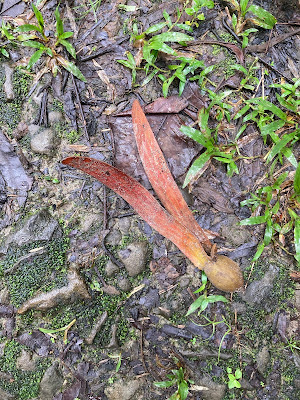Day 7 - Experiencing Dehing Patkai
7th October 6am
We were originally to check out of Namdang in the morning, but the plan changed to an afternoon check out. So it was a more relaxed morning start, meaning there was no need to pack and take our bags down. We headed for the Suraipong range of this relatively newer National Park, I think from the Digboi Duliajan Road.
 |
| It was a beautiful morning, and the road was so picturesque, with lovely lily ponds and tall trees. |
"As an exclusively arboreal species that requires contiguous, closed-canopy forests for survival, the hoolock gibbon is particularly vulnerable to the massive ongoing deforestation across northeastern India.“When a contiguous habitat is reduced to scattered smaller fragments, they become ‘habitat islands’ in an inhospitable sea of degraded habitat,” said Sharma. These conditions can lead to inbreeding, he adds. “The resultant offspring are often weak, sometimes sterile or may have little reproductive fitness.”Hoolock gibbons rarely move between forest fragments; they may refuse to cross gaps even as small as 200 meters. On top of that, they’re extremely picky about their food, and a restricted home range means limited food options.Wildlife biologist Kashmira Kakati, whose doctoral research at the University of Cambridge was on Assam’s hoolock gibbons, recalls a gibbon family she observed during her fieldwork. “An entire portion of their home range became inaccessible via the canopy because a single connecting tree was felled,” she says. “I witnessed severely emaciated juvenile gibbons — a phenomenon that occurs when they’ve to feed on leaves for prolonged periods in the absence of fruits.”"
 |
| However, there was still a roadblock, quite literally to cross. Efforts to move it failed and it was finally cut. The drivers all banding together and taking turns with the "aruvaal". |
We walked on in the meanwhile - not that we went far - since every step led a discovery.
 |
| Like this Crested Goshawk which I thought was a Kestrel. Photo by Ravi |
Anyways we meandered on and reached the entrance, and it was close to 8am already. The original idea was to be in by 630, and do a short and quick walk, and return for breakfast to the entrance, and then head out again for a walk.
Dehing Patkai, under threat from oil fires quite recently, was a name, a remote and wild place, and now here I was walking through it. Yuvan had been a moving force in the #SaveDehingPatkai movement in Chennai, and it was a relief to note that the planned coal mining has been stalled, for the moment at least.
 |
| As we walked through in humid and hot conditions, I was struck by the dipterocarps that broke though out of the canopy and formed the overstory. |
 |
| Mushrooms of different shapes and sizes were everywhere. |
A pair of great hornbills flew overhead. The forest resounded with the temple bell sound of the green cicadas. Soon, the MNS groups was strung across a wide swathe, despite the early admonitions to stay together. Arun, Sekar, Ramesh and Arjun had marched ahead along with one armed guard - they were the leading pack. I was in the middle examining the undergrowth and leaf litter, and exclaiming at every bloom and the beautiful dry leaves.
 |
| Dipterocarp seeds on the forest floor, |
 |
| as also Hingori, chestnut seeds, |
After a length of time, still no sign of the returning troops, Vijay gets restive and begins to mutter and pace. Finally, Sekar, Arjun and Ramesh return, sans Arun. Supposedly the message conveyed at the other end was that you guys are too old to make this trip, so let's return! Chinese Whispers to the power of N!!
And so we dawdled back and into the cars, met up with the local children, and went back to Namdang for a rather nice lunch with excellent Baingan bharta filled with chillies and otenga curry. The plan was to check out, land our luggage into the cars and then head back to Dehing, and then move on to Tinsukhia.
We headed back to Dehing and walked along the outer road where the guards were not required.
I gasped upon seeing the Sultan Tits - goodness what colours. A lifer for me. They were like flashes of sunshine in the canopy, flitting about here and there. I could not get enough of them, and also it was a challenge to see the whole bird as they moved so quickly and the canopy was so thick.
Probin then took us down a path where the Trogon is usually sighted. We were shushed and excited. It was sighted through the canopy! Shh - there's the head - can you see that long tail, wait wait come here, you can see the full bird. We strained and peered and finally, all of us in that group managed to piece the bird together, bit by bit!
And then we went and excitedly told the others when Yuvan shared this picture.
 |
| Red headed Trogon - Pic by Yuvan. The bird gave him a good Darshan, sitting on the branch out in the open. How blessed he was! Harpactes erythrocephalus - another lifer for me. |
And he also saw the Khalij Pheasant as did several others, but not me.
Another group had wandered down a third path where they were accosted by what looked like some guards - not Forest - who wanted to know their precedents and antecedents. And so they left from that road.
 |
| The sun was beginning to set, and we set out from Dehing to Tinsukhia. |
 |
| The last rays of the day were catching the tops of the Dipterocarps |










Wow !!!
ReplyDelete